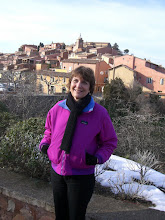
Last summer we saw a remarkable documentary called Into Great Silence which shows the daily life of a group of contemplative monks living in the French Alps near Grenoble. Just last week we were able to visit one of the contemporary monastères habités (“inhabited monasteries”) in France, l’Abbaye Notre-Dame de Sénanque. Located in an isolated valley of the Vaucluse just outside of Gordes, the Cistercian abbey is virtually surrounded by lavender fields which must be a beautiful sight in July when the flowers are in full bloom.
For six euros we took part in a guided tour of the buildings, which provided information on the history of the Cistercians and Sénanque as well as the architecture of the monastery. Our guide explained that in the eleventh century a Benedictine monk named Robert Molesme had become disillusioned with his order, which, in his eyes, had strayed from the rigor and simplicity espoused by Saint Benedict. The “reformed”
 Benedictines, including Molesme and several followers, moved to Cîteaux near Dijon and founded the first Cistercian abbey. The so-called moines blancs (because of the habit of undyed, white wool that they wear) believed in living a more austere existence of manual labor, self-denial, and prayer.
Benedictines, including Molesme and several followers, moved to Cîteaux near Dijon and founded the first Cistercian abbey. The so-called moines blancs (because of the habit of undyed, white wool that they wear) believed in living a more austere existence of manual labor, self-denial, and prayer.Named after la rivière Sénancole which runs through the property, l'Abbaye de Sénanque was founded in 1148 and reached its high point in the thirteenth and fourteenth centuries when over a hundred monks ran four mills and worked many plots of land. Disbanded when the abbey was sold after the French Revolution and once again in 1904, monks have been living in the monastery since 1988, though they presently only have a community of six.
Considered an example of pure medieval Cistercian architecture, all of the rooms at Sénanque are beautiful in their simplicity. Apparently modeled on Roman building styles, the walls were built to a certain height, then sandbags and a wooden arch were put in place, to be removed once the bricks of the arch were complete.
 The guide pointed out that the individual stones are marked with the initials of their makers and that the 860-year-old construction has survived at least one earthquake. We visited several spaces in the monastery: le dortoir des moines, a large empty room where monks slept in their clothes on des paillasses (“straw mats”) on the floor, putting oiled papers on the windows when needed to keep out the mistral; the church, l’église abbatiale, whose only ornamentation is a statue of the Virgin Mary holding the Christ child; le chauffoir, a room formerly heated by wood where monks came to copy manuscripts; le cloître, the covered area around a courtyard which has a carving of the devil at the top of one of its columns to remind the monks that temptation is all around; la salle capitulaire, or chapter house, where monks come even today to hear the daily reading of la règle de Saint Benoît, the rule of St. Benedict. The guide said that the priests can at times parler mais pas bavarder, which means that they are permitted to speak, but not to carry on conversations. It was an awe-inspiring visit.
The guide pointed out that the individual stones are marked with the initials of their makers and that the 860-year-old construction has survived at least one earthquake. We visited several spaces in the monastery: le dortoir des moines, a large empty room where monks slept in their clothes on des paillasses (“straw mats”) on the floor, putting oiled papers on the windows when needed to keep out the mistral; the church, l’église abbatiale, whose only ornamentation is a statue of the Virgin Mary holding the Christ child; le chauffoir, a room formerly heated by wood where monks came to copy manuscripts; le cloître, the covered area around a courtyard which has a carving of the devil at the top of one of its columns to remind the monks that temptation is all around; la salle capitulaire, or chapter house, where monks come even today to hear the daily reading of la règle de Saint Benoît, the rule of St. Benedict. The guide said that the priests can at times parler mais pas bavarder, which means that they are permitted to speak, but not to carry on conversations. It was an awe-inspiring visit.

No comments:
Post a Comment